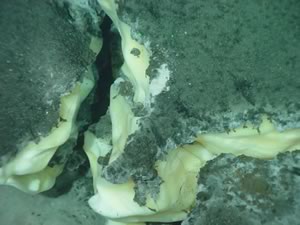UVic Researchers Find Canyon Full of Methane Hydrates

Canada
may have another energy resource, thanks to a discovery made by an ocean
researcher at the University of Victoria.
UVic geophysicist Dr. Ross Chapman and the crew of Canadian Coast Guard Ship John P. Tully travelled to Barkley Canyon, just off Ucluelet, last month where they found the largest amount of methane hydrates ever discovered on the sea floor off Canada. The finding has two major implications. First of all, methane hydrates are a potential alternative energy source. Secondly, scientists suspect its release from the ocean floor during earthquakes may add to greenhouse gas levels in the Earth’s atmosphere.
Chapman and his colleagues have been researching methane hydrates for 10 years and have been using the Canadian submersible ROPOS (Remotely Operated Platform for Ocean Science) to look for evidence on the sea floor. But until now he has never seen such huge mounds of hydrates in Canadian waters.
“At first, we knew the methane hydrates existed because of seismic investigations offshore,” says Chapman. “But when we sent our remotely operated submersible down 850 metres to the sea floor we found masses of methane hydrates mounds. Most of them were three or four metres high and 10 metres wide. We even saw one with a cap of pure hydrate that was as big as a Volkswagen Bug.”
Chapman estimates that the deposit takes up three or four square kilometers of the sea floor and are found at depths around 850 metres below the ocean’s surface. “On our second day out we saw small oil slicks on the ocean’s surface. At first we thought they were from the submersible or the ship. But they were actually coming from the methane hydrates. When we tested the oil we discovered that it had come from deeper in the sediments and had the consistency of a highly refined gasoline.”
Chapman’s research and field studies are funded by Canada’s Natural Sciences and Engineering Research Council (NSERC). Next year, he will return to Barkley Canyon to obtain more samples of oil, gas and hydrates. Chapman and his colleagues will also take heat flow measurements to determine fluid flow in the region and complete a detailed seismic survey to see if there are other sites nearby.
UVic geophysicist Dr. Ross Chapman and the crew of Canadian Coast Guard Ship John P. Tully travelled to Barkley Canyon, just off Ucluelet, last month where they found the largest amount of methane hydrates ever discovered on the sea floor off Canada. The finding has two major implications. First of all, methane hydrates are a potential alternative energy source. Secondly, scientists suspect its release from the ocean floor during earthquakes may add to greenhouse gas levels in the Earth’s atmosphere.
Chapman and his colleagues have been researching methane hydrates for 10 years and have been using the Canadian submersible ROPOS (Remotely Operated Platform for Ocean Science) to look for evidence on the sea floor. But until now he has never seen such huge mounds of hydrates in Canadian waters.
“At first, we knew the methane hydrates existed because of seismic investigations offshore,” says Chapman. “But when we sent our remotely operated submersible down 850 metres to the sea floor we found masses of methane hydrates mounds. Most of them were three or four metres high and 10 metres wide. We even saw one with a cap of pure hydrate that was as big as a Volkswagen Bug.”
Chapman estimates that the deposit takes up three or four square kilometers of the sea floor and are found at depths around 850 metres below the ocean’s surface. “On our second day out we saw small oil slicks on the ocean’s surface. At first we thought they were from the submersible or the ship. But they were actually coming from the methane hydrates. When we tested the oil we discovered that it had come from deeper in the sediments and had the consistency of a highly refined gasoline.”
Chapman’s research and field studies are funded by Canada’s Natural Sciences and Engineering Research Council (NSERC). Next year, he will return to Barkley Canyon to obtain more samples of oil, gas and hydrates. Chapman and his colleagues will also take heat flow measurements to determine fluid flow in the region and complete a detailed seismic survey to see if there are other sites nearby.
-- 30 --
Photos
Media contacts
Dr. Ross Chapman (earth and ocean sciences) at (250) 472 4340
Click here for the backgrounder.